Sixty-three Chinese incursions into waters and airspace around Taiwan were detected in the 24 hours to 6am yesterday, with 38 craft crossing the median line of the Taiwan Strait and entering the nation’s northern, central, southwestern and eastern air defense identification zones, the Ministry of National Defense (MND) said.
The activity represented a ramp-up of Beijing’s “gray zone” warfare directed at Taiwan over the past two days, the ministry said.
A wave of 31 Chinese craft, consisting of fighters, fighter-bombers and uncrewed aerial vehicles, was tracked from 5:45am to 7:50am on Thursday, it said.
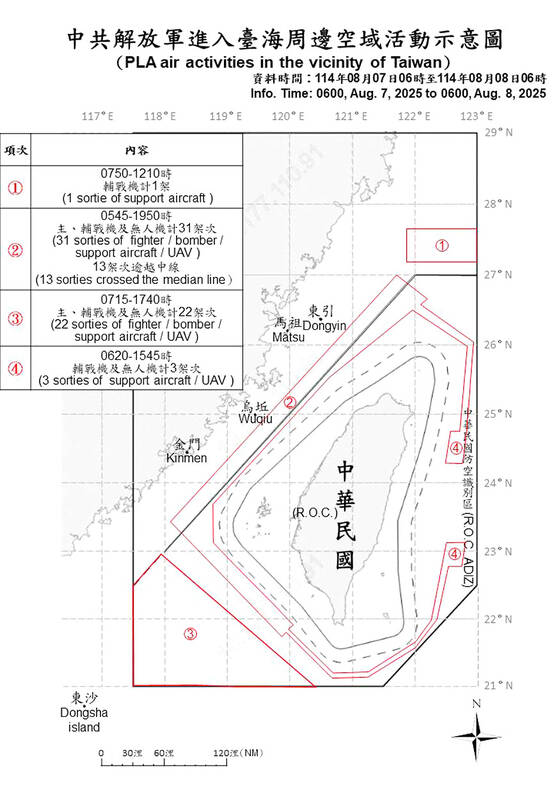
Photo courtesy of the Ministry of National Defense
In an apparent act of provocation, 13 of them crossed the median line before flying outside the nation’s territorial waters to enter the eastern identification zone, it said.
Another 22 of a similar composition were tracked from 6:20am to 3:54pm on Thursday in Taiwan’s southwestern identification zone, all of which crossed the median line, the ministry said.
A lone fighter was tracked in the northern zone from 7:50am to 12:10pm, it said.
The armed forces responded to the movements by the Chinese People’s Liberation Army (PLA) aircraft and ship movements by deploying fighters and warships, and alerting air and coast defense missile units, the ministry said.
Meanwhile, an unidentified PLA aircraft was spotted flying from the East China Sea to airspace between Taiwan proper and Japan’s Yonaguni Island, the Japanese Ministry of Defense said in a statement yesterday.
The aircraft loitered off Hualien County, it said, adding that a Japan Air Self-Defense Force fighter was deployed to surveil it.
The Chinese aircraft in the Japanese statement was not in the MND’s count.
Taiwan’s armed forces from 6am on Wednesday to 6am on Thursday tracked 15 PLA aircraft around Taiwan proper, with 14 entering Taiwan’s northern defense zone, the MND said.
Seven warships and one other Chinese government vessel were active in waters near Taiwan proper, it added.
China continues to escalate its harassment of Taiwan’s air and sea space, showing that Beijing is the true troublemaker in the Indo-Pacific region, it said.
The rise in Chinese military activity coincided with former British prime minister Boris Johnson’s visit to Taiwan and preceded a planned visit to Japan by the Royal Navy’s Prince of Wales aircraft carrier.
Beijing and Moscow earlier this month began a joint naval exercise in waters between Japan and the Korean Peninsula, with warships sailing in La Perouse Strait to the north of Japan and the Miyako Strait to its south.
It is not known if the Chinese and Russian fleets would sail around Japan as they did last year.
Additional reporting by Aaron Tu
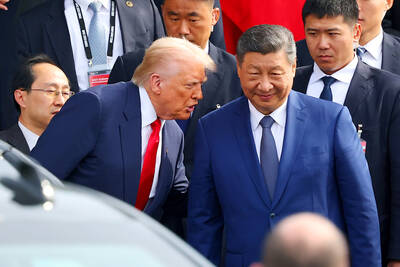
UKRAINE, NVIDIA: The US leader said the subject of Russia’s war had come up ‘very strongly,’ while Jenson Huang was hoping that the conversation was good Chinese President Xi Jinping (習近平) and US President Donald Trump had differing takes following their meeting in Busan, South Korea, yesterday. Xi said that the two sides should complete follow-up work as soon as possible to deliver tangible results that would provide “peace of mind” to China, the US and the rest of the world, while Trump hailed the “great success” of the talks. The two discussed trade, including a deal to reduce tariffs slapped on China for its role in the fentanyl trade, as well as cooperation in ending the war in Ukraine, among other issues, but they did not mention
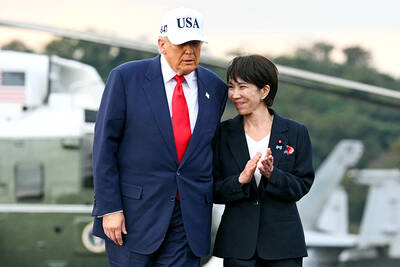
Japanese Prime Minister Sanae Takaichi yesterday lavished US President Donald Trump with praise and vows of a “golden age” of ties on his visit to Tokyo, before inking a deal with Washington aimed at securing critical minerals. Takaichi — Japan’s first female prime minister — pulled out all the stops for Trump in her opening test on the international stage and even announced that she would nominate him for a Nobel Peace Prize, the White House said. Trump has become increasingly focused on the Nobel since his return to power in January and claims to have ended several conflicts around the world,
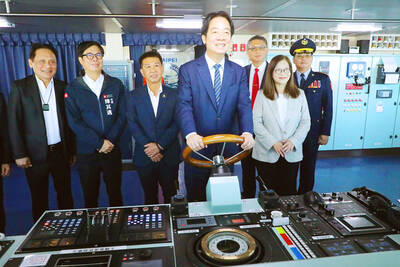
CALL FOR SUPPORT: President William Lai called on lawmakers across party lines to ensure the livelihood of Taiwanese and that national security is protected President William Lai (賴清德) yesterday called for bipartisan support for Taiwan’s investment in self-defense capabilities at the christening and launch of two coast guard vessels at CSBC Corp, Taiwan’s (台灣國際造船) shipyard in Kaohsiung. The Taipei (台北) is the fourth and final ship of the Chiayi-class offshore patrol vessels, and the Siraya (西拉雅) is the Coast Guard Administration’s (CGA) first-ever ocean patrol vessel, the government said. The Taipei is the fourth and final ship of the Chiayi-class offshore patrol vessels with a displacement of about 4,000 tonnes, Lai said. This ship class was ordered as a result of former president Tsai Ing-wen’s (蔡英文) 2018
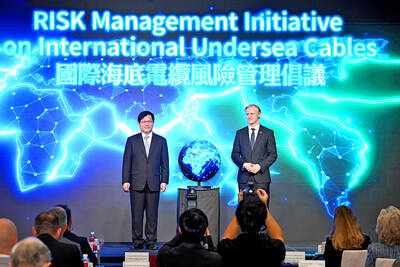
GLOBAL PROJECT: Underseas cables ‘are the nervous system of democratic connectivity,’ which is under stress, Member of the European Parliament Rihards Kols said The government yesterday launched an initiative to promote global cooperation on improved security of undersea cables, following reported disruptions of such cables near Taiwan and around the world. The Management Initiative on International Undersea Cables aims to “bring together stakeholders, align standards, promote best practices and turn shared concerns into beneficial cooperation,” Minister of Foreign Affairs Lin Chia-lung (林佳龍) said at a seminar in Taipei. The project would be known as “RISK,” an acronym for risk mitigation, information sharing, systemic reform and knowledge building, he said at the seminar, titled “Taiwan-Europe Subsea Cable Security Cooperation Forum.” Taiwan sits at a vital junction on